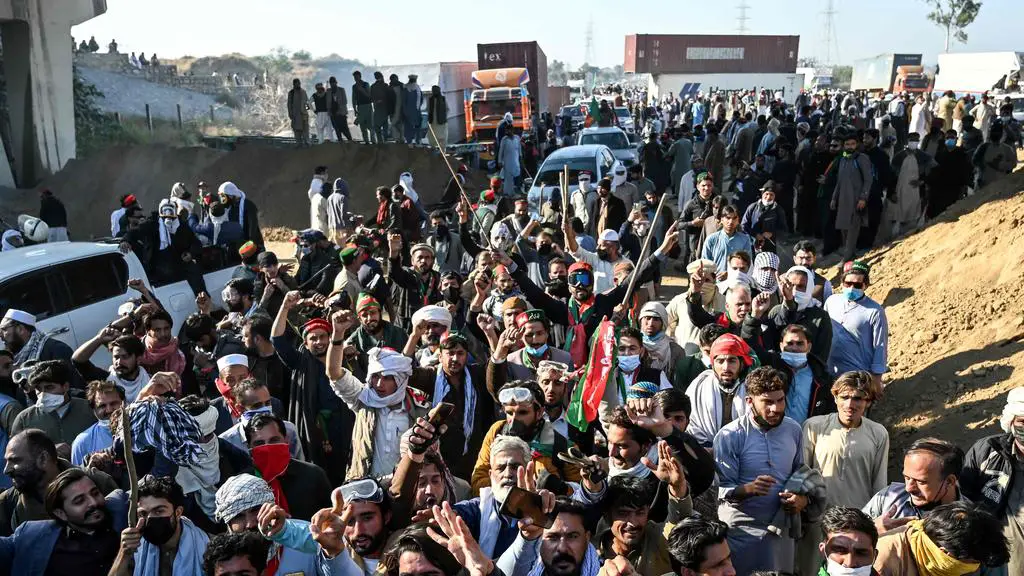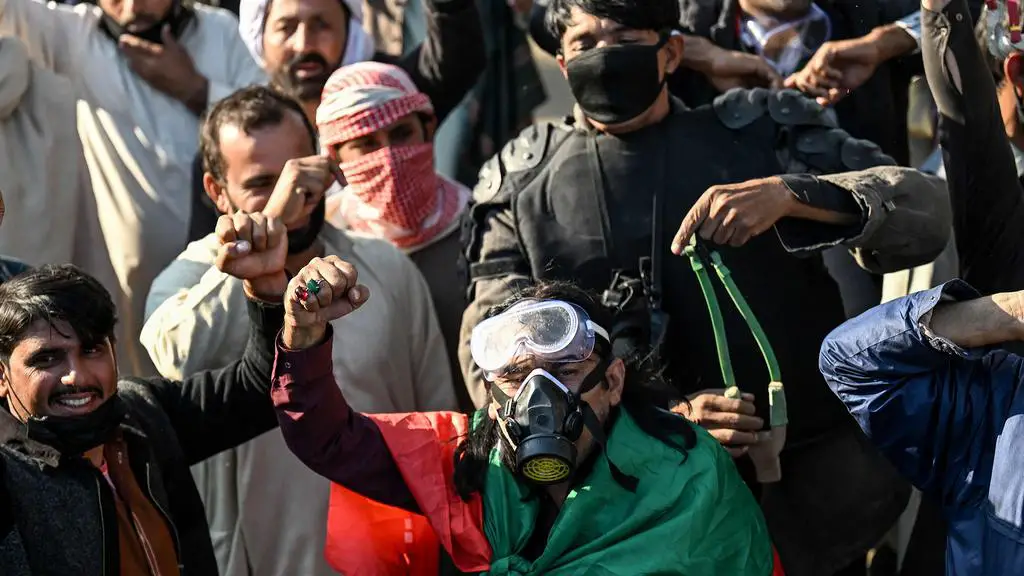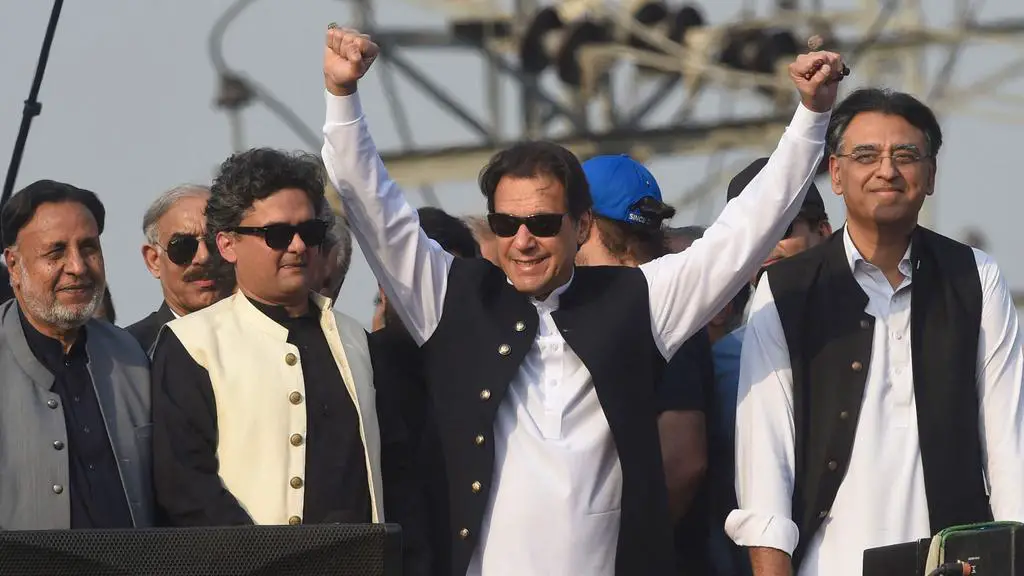Islamabad has become the epicenter of political unrest as thousands of protesters demand the release of former Prime Minister Imran Khan. With one police officer dead, over 119 injured, and 22 police vehicles torched in violent clashes, the crisis underscores deepening fissures in the nation’s political and judicial systems. The ongoing unrest, marked by a tense standoff between Khan’s supporters and state forces, is paralyzing the country and raising concerns about its security and stability.
The Roots of the Crisis
The protests were sparked by the arrest of Imran Khan, leader of the Pakistan Tehreek-e-Insaf (PTI) party, and his call for a mass demonstration in Islamabad. Khan, who faces numerous corruption charges, alleges that his incarceration is politically motivated. His supporters accuse the government of tampering with the February elections and exploiting constitutional amendments to consolidate power over the judiciary.
The tensions have been exacerbated by the government’s recent push to pass amendments giving it greater control over the courts. These changes have fueled allegations of judicial interference, particularly as Khan battles dozens of legal cases. His wife, Bushra Bibi, and key PTI leaders have also faced legal challenges, further galvanizing supporters who view the arrests as a crackdown on political dissent.
Supporters of Khan, many traveling from Khyber Pakhtunkhwa and Punjab provinces, converged on Islamabad after a weekend of mobilization. The demonstrations escalated as protesters clashed with riot police on the city’s outskirts and along major motorways. According to reports, violence broke out near Islamabad’s western motorway entry point, with protesters torching police vehicles and pelting officers with stones.
Security forces responded with tear gas, baton charges, and mass arrests. Despite their efforts, the demonstrators pushed toward D-Chowk, a high-security area in the Red Zone that houses Pakistan’s parliament and Supreme Court. As of Tuesday, the region remains a flashpoint for potential escalations.
The Toll on Security and Daily Life
Since the protests began, Islamabad has been effectively paralyzed. Authorities deployed over 20,000 riot police, equipped with batons and shields, to secure key locations and prevent further unrest. Roadblocks made of shipping containers have cut off major entry and exit points, while sporadic mobile internet shutdowns have disrupted communication. Schools, universities, and businesses remain closed amid fears of violence, leaving the city at a standstill.
The economic toll of this unrest cannot be overstated. Trade routes between provinces have been disrupted, public transportation halted, and tourism in the capital has ground to a halt. The ripple effects extend beyond Islamabad, affecting neighboring Punjab and Khyber Pakhtunkhwa, where protests have also flared.
While Islamabad bears the brunt of the unrest, the protests have reverberated across Pakistan’s provinces. Punjab, the nation’s political heartland, has seen intense clashes between PTI supporters and security forces. Public infrastructure has been damaged in Lahore and Rawalpindi, and civilian life has been disrupted.
Khyber Pakhtunkhwa, a stronghold of Khan’s PTI, has emerged as the base for the protest movement. Ali Amin Gandapur, the province’s chief minister and a key ally of Khan, is leading one of the main convoys into Islamabad. The region’s active participation highlights the divide between PTI-controlled areas and the federal government, complicating efforts to maintain nationwide unity.

Implications for National Security
The ongoing unrest has raised alarm bells for Pakistan’s national security. The deployment of tens of thousands of police has strained resources, leaving gaps in other areas. With protests spreading to multiple provinces, the risk of destabilization is growing.
Moreover, the crisis is taking place against the backdrop of Pakistan’s fragile economic situation. Political instability threatens to further erode investor confidence, complicating efforts to secure international aid and manage the country’s mounting debts. The disruption of trade and daily commerce due to road closures and internet blackouts only adds to the economic woes.
The international community has expressed concern over the deteriorating situation. Human rights organizations have called on the Pakistani government to ensure the rights of peaceful protesters while urging restraint from both sides to avoid further casualties.
Regional powers are also closely monitoring developments. Pakistan’s instability has implications for South Asia’s geopolitics, particularly in the context of ongoing tensions with neighboring India. Islamabad’s lockdown has drawn attention from global observers, who fear that prolonged unrest could have far-reaching consequences for regional stability.

Crackdown or Concession?
The Pakistani government faces a critical decision: escalate its crackdown on protesters or seek a political resolution through dialogue. Both options carry significant risks. A heavy-handed approach could escalate violence, leading to further casualties and deepening public resentment. However, concessions to PTI protesters might embolden future challenges to state authority.
The government has already faced criticism for its security measures, including mass arrests and internet shutdowns, which some see as disproportionate. The question remains whether these measures can prevent further unrest or if they will only fuel the anger of Khan’s supporters.
For Imran Khan and the PTI, the protests are a high-stakes gamble. By mobilizing supporters en masse, Khan seeks to pressure the government and judiciary into granting his release and addressing PTI grievances. However, this strategy risks alienating moderate Pakistanis who may view the unrest as a destabilizing force.
Khan’s ability to sustain the protests will depend on his party’s organizational capacity and his supporters’ willingness to endure prolonged hardship. The involvement of key figures like Bushra Bibi and Ali Amin Gandapur adds weight to the movement, but it also exposes PTI leadership to potential arrests and legal challenges.
Navigating a Perilous Landscape
Pakistan stands at a crossroads, grappling with an intensifying political crisis that threatens its security and stability. Resolving the unrest will require a careful balancing act between maintaining law and order and addressing the grievances driving the protests.
Dialogue between the government and PTI leadership could offer a path forward, but mutual distrust makes this option challenging. Meanwhile, international observers and civil society groups will likely play a crucial role in advocating for a peaceful resolution.
The coming days will be pivotal in determining whether Pakistan can pull back from the brink of further chaos or if the protests will mark the beginning of a prolonged period of instability. For now, the streets of Islamabad remain tense, as the nation watches and waits.
The protests in Islamabad are a microcosm of Pakistan’s broader struggles with political polarization, judicial independence, and economic fragility. As the capital remains locked down and violence spreads, the crisis underscores the urgent need for leadership and dialogue. Without meaningful efforts to bridge divides and address grievances, Pakistan risks plunging further into turmoil.



